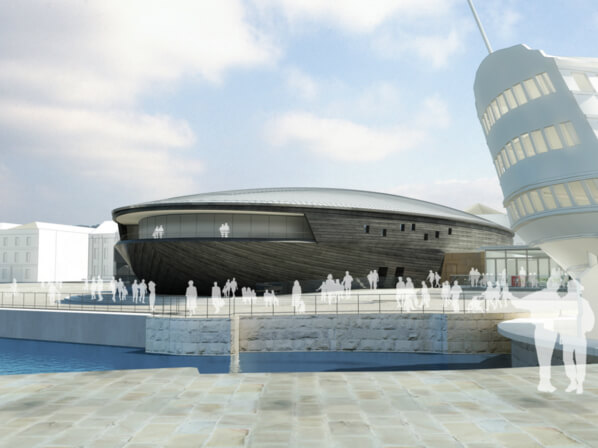JCT Design and Build contract is used for the next chapter of the Tudor warship’s conservation story.
It’s been over thirty years since the Mary Rose was excavated from the Solent near Portsmouth and placed in its current location at the centre of Portsmouth’s Historic Dockyard. The Tudor warship, which sank on 19 July 1545, along with 19,000 artefacts, gives a unique view into nautical history.
More than simply a display piece however, the Mary Rose is a mixture of museum and complex conservation project. Over the last 17 years visitors have been able to view the hull through a shroud of spray – part of the process of treating the ship with polyethylene glycol, in order to preserve the timber. The Mary Rose’s current home, along with a separate building to house the artefacts salvaged from the wreck, has told the story not only of Tudor maritime life, but also the story of the expertise involved in preserving a historically important and fragile monument.
In the next chapter of the ship’s history (and to a large extent, her future) a new building will bring together the ship and the artefacts for the first time, allowing the delicate conservation process to continue, as well as creating one of the world’s largest exhibits as part of a first-class visitor attraction.
In its role in the conservation of the ship, the new museum has been specifically designed to carry out the next essential stage, which involves drying out the hull in a controlled environment. The building is erected over a ‘hotbox’ – a plastic and fibreglass structure – which allows the lighting, humidity and temperature to be strictly controlled in order to remove the 100 tonnes of water contained within the ship’s timbers. This final phase of the project is due to end in 2016, and visitors will still be able to see the hull during this drying phase, through specially designed windows.
Once the drying phase is complete, the hotbox will be removed, revealing the elliptical jewel box that will house the ship, resulting in a fully integrated display that shows the Mary Rose and its artefacts to the public in a completely new way.
The £35m project was designed through a combination of Wilkinson Eyre Architects providing the conceptual design, Pringle Brandon Perkins+Will designing the interiors, and ECE Architecture working as the delivery architects. The design features a virtual hull alongside the original structure, with viewing galleries running the length of the ship. Decks will be built aligned with the ship that will show over 4,000 of the artefacts in their original archaeological context, just moments before the ship sunk. The finely crafted wooden jewel box is clad in timber planks, which reflects the beauty and spirit of the Mary Rose herself. The main contractor for the project is Warings, part of the Bouygues group.
The inspiration for ship-housed-within-hotbox-housed-within-building seems to be related to the Russian doll series of challenges that had to be overcome to complete the project. Using a JCT Design and Build Contract, Warings worked in partnership with ECE Architecture – the delivery architects – during the development phase. The first task to be overcome was how to construct a building over a 450-year-old Tudor ship, which cannot be moved and is still undergoing a conservation process. Another layer of the challenge was the ship’s current location – Dry dock number three at Portsmouth’s Historic Dockyard, which is a scheduled ancient monument in its own right.
The building has combined the best architectural, engineering and construction expertise to carefully build around the vessel whilst still allowing the necessary preservation processes to continue, providing the switch over to the next stage. The shell-shaped roof, for instance, was prefabricated and lifted into place over the existing ship hall. All works have also been completed under the supervision of an archaeologist to ensure that the ship and its historic location are carefully preserved.
By using JCT’s Design and Build Contract, and keeping the complex design and construction parts of the project in one place, the project team was able to work collaboratively to achieve a successful outcome.
As well as the exhibit display, the new museum building also includes a number of additional facilities, including new rooms for restoration, learning and education; museum shop and visitors’ cafe.
The new museum is expected open to visitors in early 2013. A construction time-lapse video of the entire project can be viewed at the Mary Rose Trust website at www.maryrose.org/new_museum/videoplayer.html.
Photo Credits:
Pringle Brandon
Perkins+Will (interior),
Wilkinson Eyre (exterior)

